I suspect wing-flapping behavior is probably instinctive but I believe this chick was taking its cue from its father.
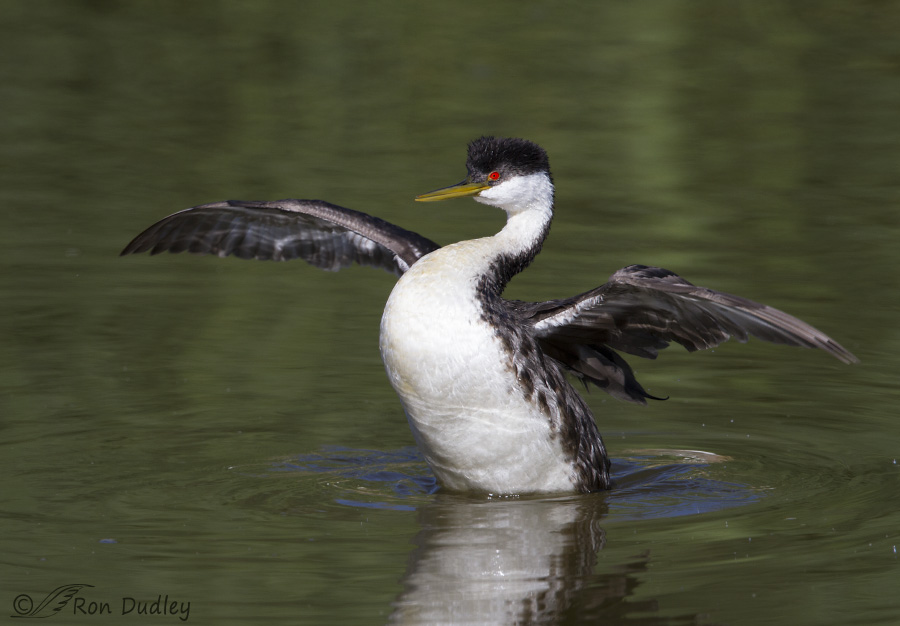 1/2000, f/6.3, ISO 400, Canon 7D, Canon EF 500mm f/4L IS II USM + 1.4 tc, not baited, set up or called in
1/2000, f/6.3, ISO 400, Canon 7D, Canon EF 500mm f/4L IS II USM + 1.4 tc, not baited, set up or called in
I spent quite a while with a family of Western Grebes three days ago at Bear River Migratory Bird Refuge – based on the size and straightness of the bill I believe this to be the adult male. He was being pestered by one of his chicks (just out of frame) when he suddenly rose up in the water and executed an impressive and extended wing-flap.
The chick apparently noticed the performance…
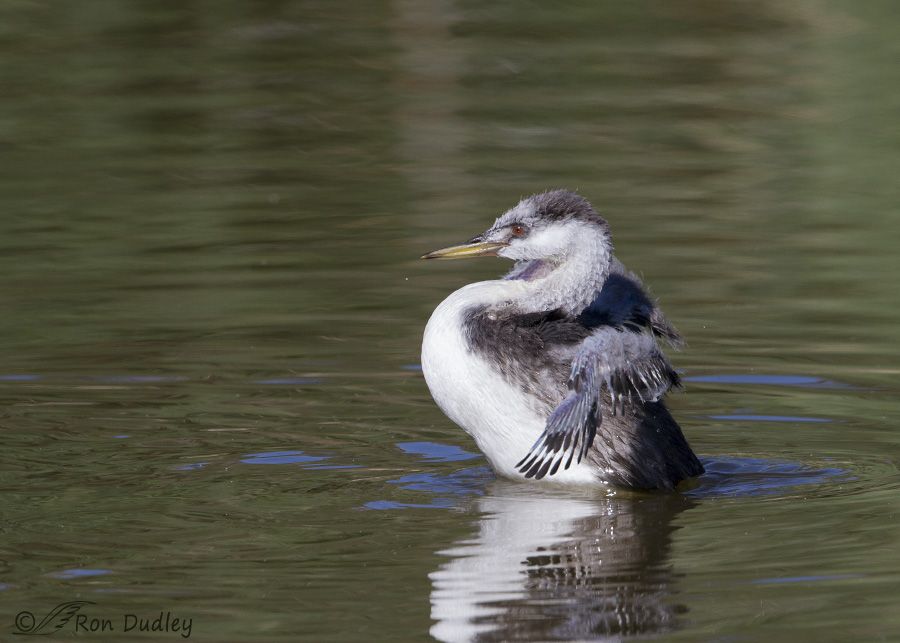
1/2000, f/6.3, ISO 400, Canon 7D, Canon EF 500mm f/4L IS II USM + 1.4 tc, not baited, set up or called in
because the youngster soon began a wing-flap of its own (these 12 images of the chick are all sequential without any “skips”).
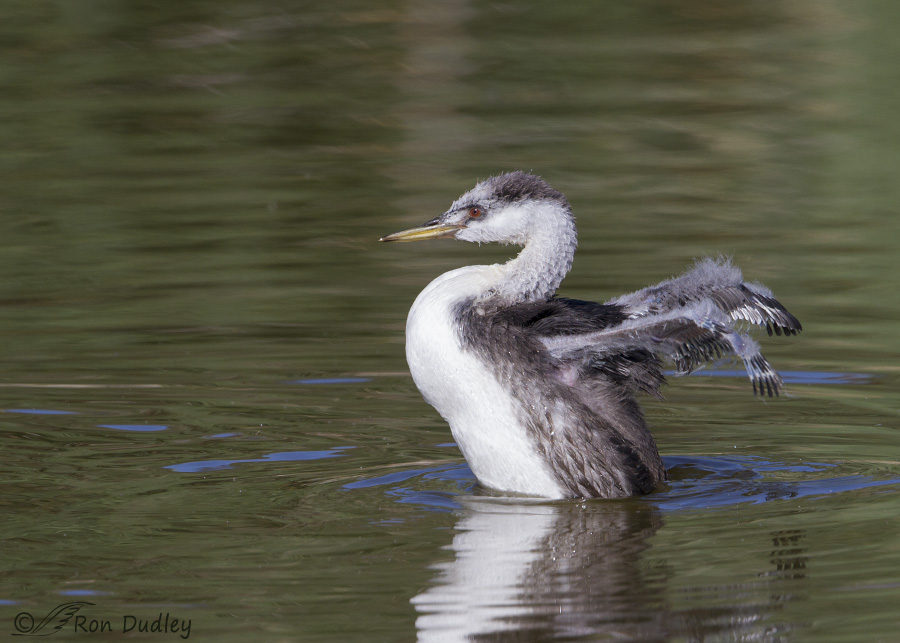
1/2000, f/6.3, ISO 400, Canon 7D, Canon EF 500mm f/4L IS II USM + 1.4 tc, not baited, set up or called in
Like its parent it rose vertically out of the water for the performance.
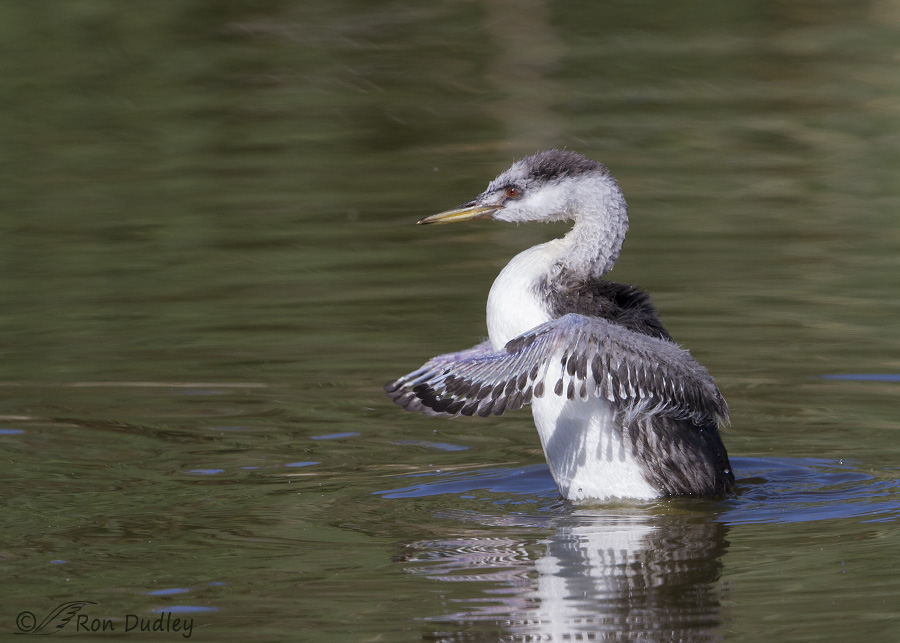
1/2000, f/6.3, ISO 400, Canon 7D, Canon EF 500mm f/4L IS II USM + 1.4 tc, not baited, set up or called in
At this young age the vanes of the flight feathers have just recently begun to emerge from their shafts.
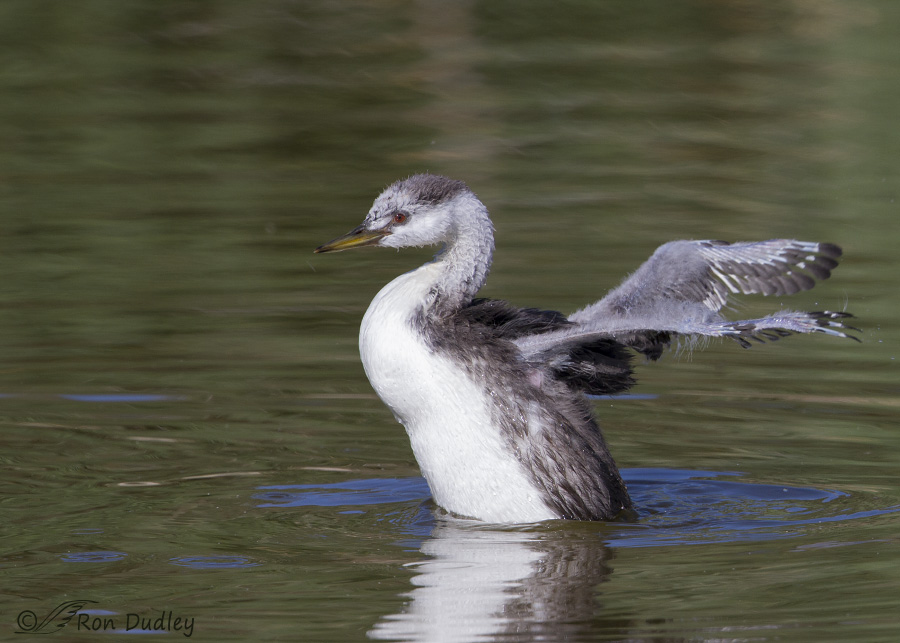
1/2000, f/6.3, ISO 400, Canon 7D, Canon EF 500mm f/4L IS II USM + 1.4 tc, not baited, set up or called in
With relatively little air resistance from its undeveloped flight feathers its wings flopped and flailed at awkward angles.
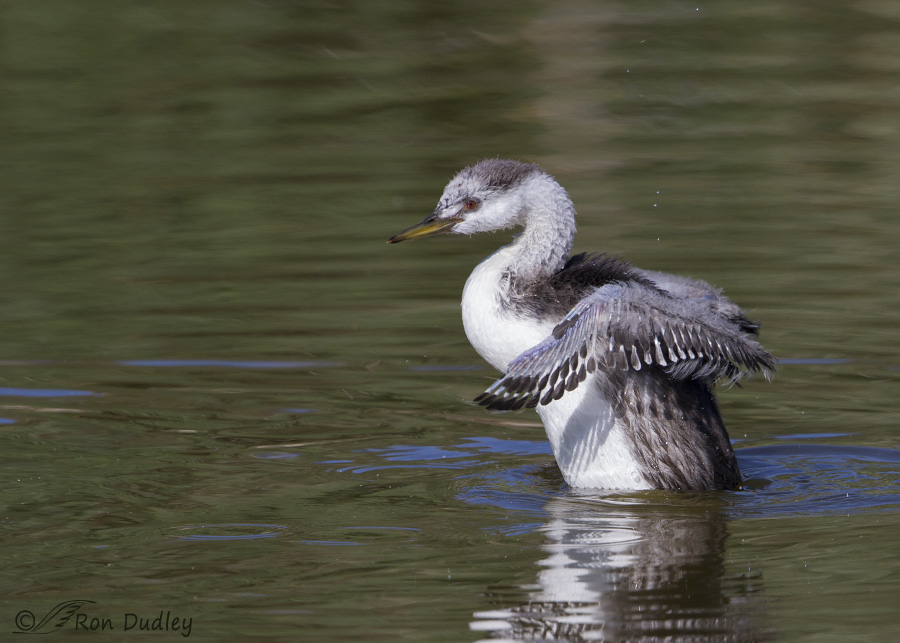
1/2000, f/6.3, ISO 400, Canon 7D, Canon EF 500mm f/4L IS II USM + 1.4 tc, not baited, set up or called in
The primary feathers first emerge at about 40 days and complete growth at 70 days so I’d estimate the age of this chick at just under 7 weeks.
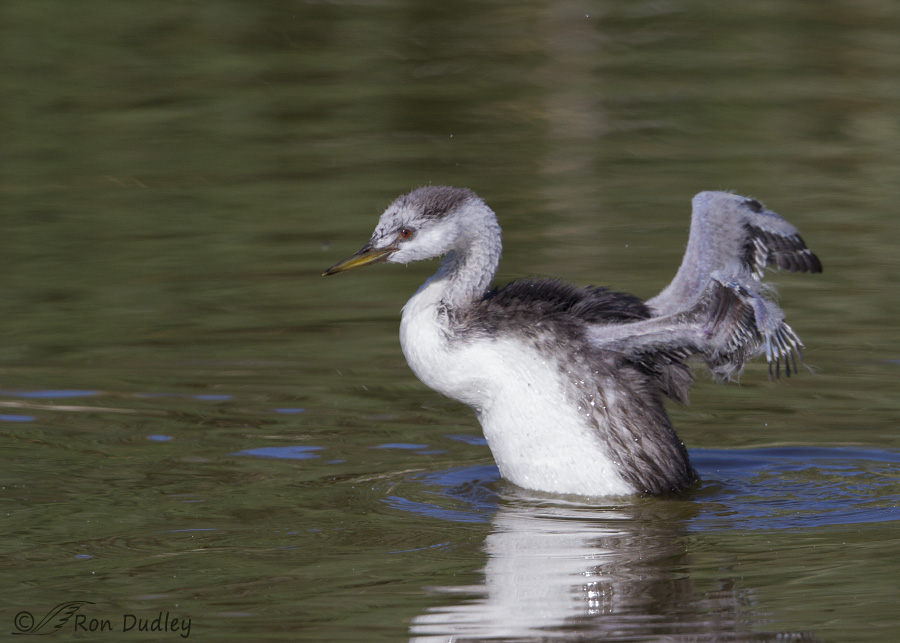
1/2000, f/6.3, ISO 400, Canon 7D, Canon EF 500mm f/4L IS II USM + 1.4 tc, not baited, set up or called in
Those immature wings really flopped around. I suspect part of the reason for this behavior at this age is much-needed muscle development.
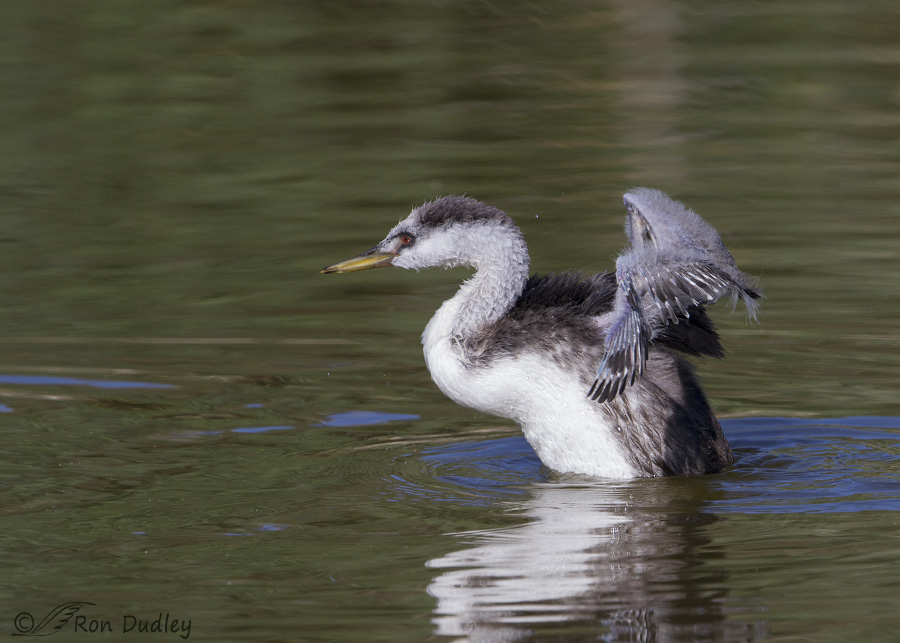
1/2000, f/6.3, ISO 400, Canon 7D, Canon EF 500mm f/4L IS II USM + 1.4 tc, not baited, set up or called in
Here the bird is just beginning to settle back down in the water.
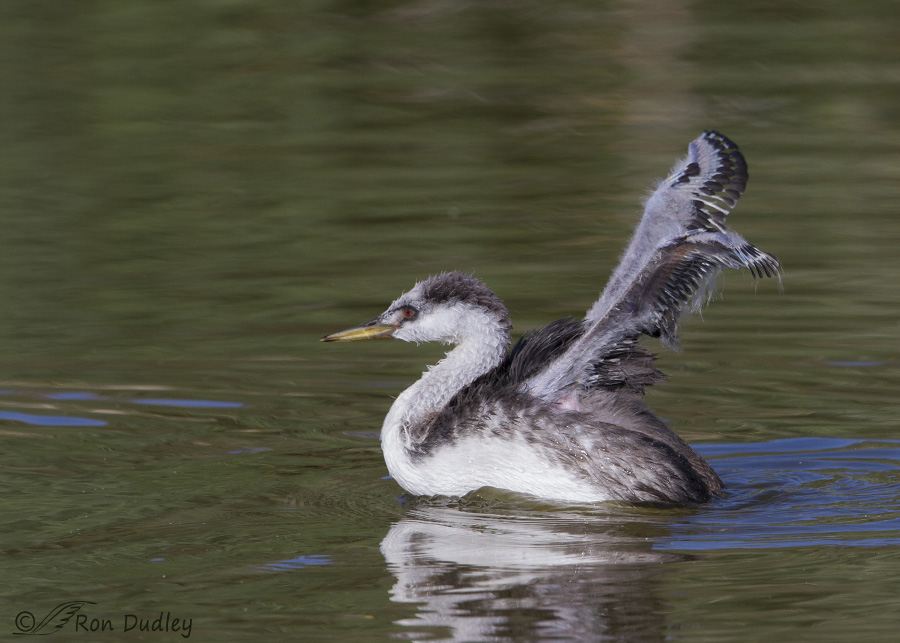
1/2000, f/6.3, ISO 400, Canon 7D, Canon EF 500mm f/4L IS II USM + 1.4 tc, not baited, set up or called in
At this point it seemed unsure about what to do with its wings when the wing-flapping was over.
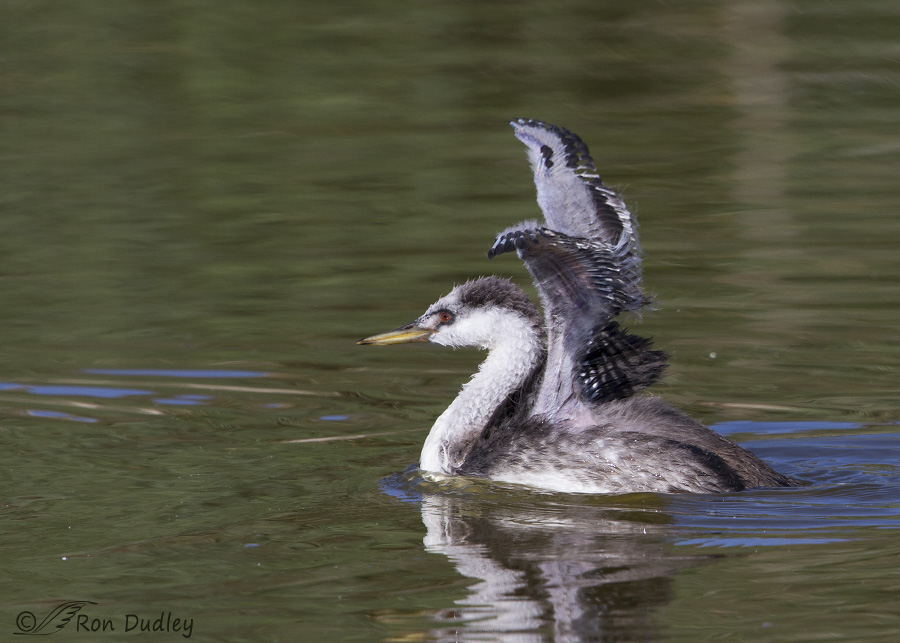
1/2000, f/6.3, ISO 400, Canon 7D, Canon EF 500mm f/4L IS II USM + 1.4 tc, not baited, set up or called in
It held them vertically for a few moments (adults don’t do this)…
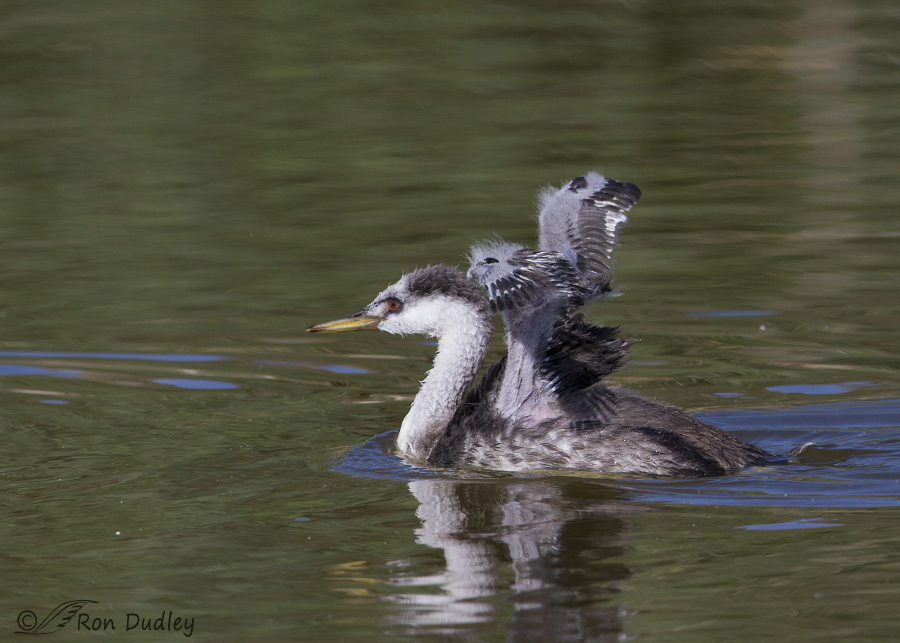
1/2000, f/6.3, ISO 400, Canon 7D, Canon EF 500mm f/4L IS II USM + 1.4 tc, not baited, set up or called in
and then slowly began to fold them…
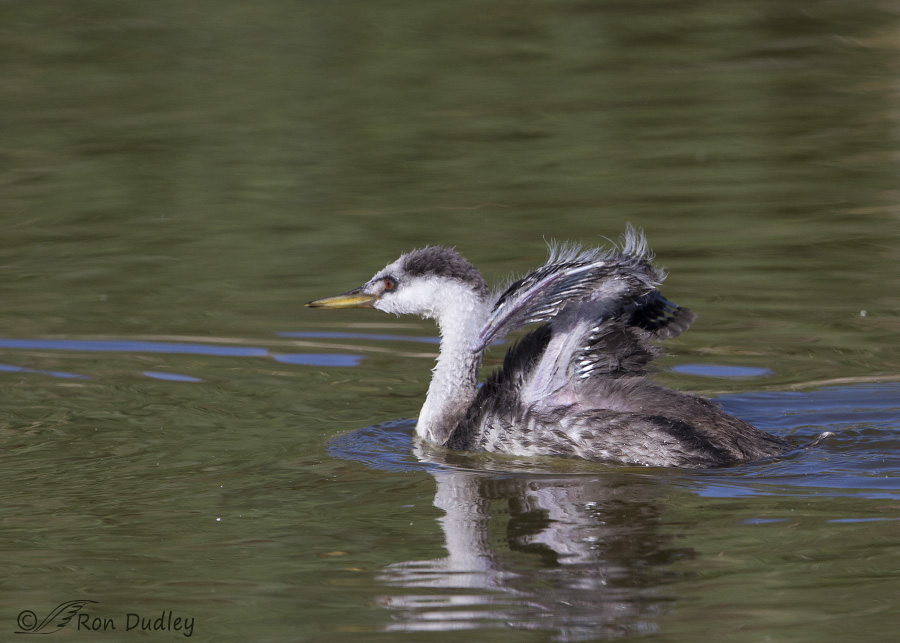
1/2000, f/6.3, ISO 400, Canon 7D, Canon EF 500mm f/4L IS II USM + 1.4 tc, not baited, set up or called in
back into place.
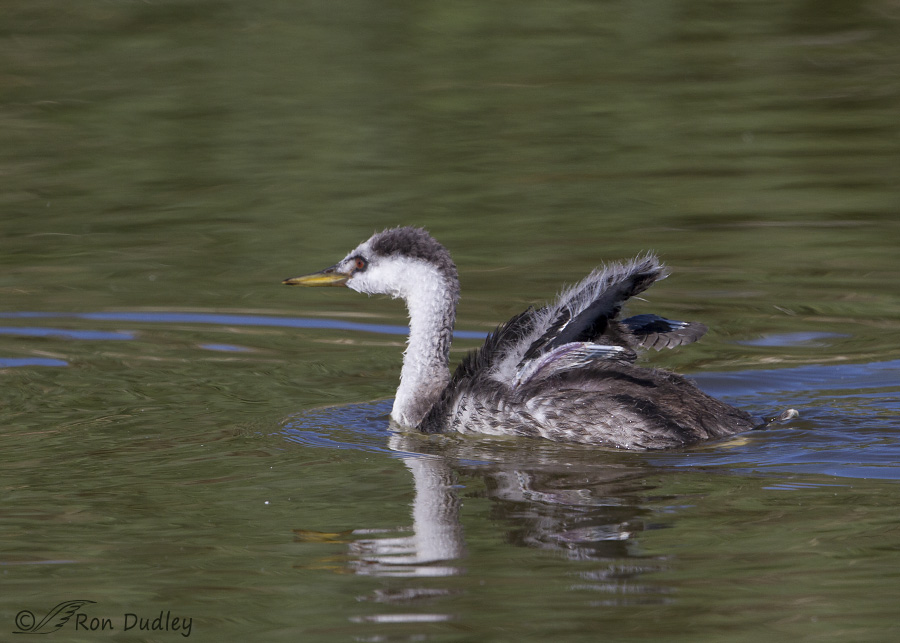
1/2000, f/6.3, ISO 400, Canon 7D, Canon EF 500mm f/4L IS II USM + 1.4 tc, not baited, set up or called in
Finally, when it figured out where everything belonged, the wing-flap was completed.
This was the first time I’d seen a chick at this age perform a wing-flap so I thought it was pretty neat. Maybe I overdid it a little with 13 images but I liked seeing as much of the behavior as possible and I thought readers might enjoy the same thing.
Ron


This is so cute and I agree with what everyone else said. You are always at the right place at the right time!
I thought it might be the same youngster. I guess he’s learning “by leaps and bounds” or by “slapping (with dad’s foot) and flapping”.
Awe-inspiring to think that these young ones will be ready in just a few short weeks to fly elsewhere, propably a long distance.I have no idea where they migrate to.
Jane, these birds migrate south to a variety of areas but many of them end up on the west coast. Some of ours in northern Utah actually stick around almost all winter when the weather is milder than usual and the ponds don’t freeze up.
What a wonderful series. Thank you Ron!
Thanks, Cindy.
WHAT a series. And wash your mouth out on the ‘over-done’ front. This is fascinating. I suspect that rising straight out of the water like that also requires some impressive muscles.
What EC said! Just STOP saying that. If it’s ever too many, we can close the post! Abundance is a good thing! 😉
Ron, thanks for pointing out the feather development. And for the endearing photos of how birds, and probably us “human” animals learn by copying those close to us. Wonder Full
You’re very welcome, Diana. Thanks.
Thank you for sharing these photos of the juvenile. I knew very little about Grebes before I saw your recent photos and I am loving what I am seeing!
Thank you, Pat.
Beautiful series. The extra shots are enjoyably, it is nice to compare the wing positions, specially those awkward movements. I too am surprised at how long it takes them to “feather-up”. Most birds have their first adult plumage in by 40 days.
I went to BRMBR last night, I was shocked at the large barren dry ponds and canals. Even the ponds where the water is diverted to are low. You go more often than I do, is this normal for this time of year or unusually low? Can the remaining ponds support the LARGE number of birds I saw? I was amazed how many of each species I saw! It reminded me of a public swimming pool on a hot day, crowded with screaming kids. There were hundreds of snowy egrets.
April, I was out there a few days ago and you’re right, it’s pretty dry, but it often is this time of year – especially with the recent drought. They were planning on keeping the loop road closed for two weeks to work on the dikes (plans apparently changed because it was only closed for two days) so maybe they drained some of the ponds and canals in preparation for that work.
April, I love that image of a public swimming pool with screaming kids!
I love this series! The young bird looks so so serious and determined to “get it right”…not easy with those “unsheathed” feathers! Birds looks pretty darned cute, though…
I think they’re cute at that age too, Patty. Thanks.
What a delight to see little ones learning. We all emulate our parents–well many of us (across species lines). Oh yeah, and insert the usual Oh WOW here!
I’m surprised that feather growth happens so much later (compared to raptors). By 40 days of age, redtails’ feathers are roughly three-quarters (or more) of the way finished growing and about 10 days away from fledging, give or take. I guess some kiddos get a (slightly) longer childhood than raptors. But on the similar side of things, raptors also have to figure out what those lovely wings, feet and other miscellaneous parts do. Initially, raptors use their stubby wings as elbows during the stage when they’re just beginning to move around the nest–roughly equivalent to the crawling stage in humans. The Western Grebes (and other water birds) are mobile in the water early on in the process, but they still need to figure out how all the new parts work 😉
What a delight! THANK YOU again! I just love the behavioral parts of your photography!
Interesting statistics you provide on the development stages of feathers on raptor chicks, Laura. Thank you.
Well, they weren’t really statistics, but more estimations, and I was a little off–my memory is like the Lucas electrical switch: dim, flicker and off. The usual fledging range for redtails is 42 to 46 days (or a few more if their parents keep feeding them), so at 40 days, they’re almost full summed (feathers fully grown). The Western Grebes’ feathers are still in the paint brush stage and have a lot farther to go before they’re done growing. Very interesting!
And thanks to Gretchen Peterson for the statistics on the Cornell University redtails 😉
Another terrific series. Love that baby trying ot be just like Daddy!!
Thank you, Ellen.
These are awesome behavioral shots Ron!
Charlotte
I’m glad you enjoyed them, Charlotte.
I’m so glad that you posted this series of photos–I wouldn’t have guessed that water chicks would need to do “exercises” as they are developing ; one is
used to seeing elevated nest chicks do these aerobics . Your work “exercises” my imagination almost every day—thanks !
Thank you, Kris.
those are so adorable, thank you for sharing
Thanks, Carlotta.
Wonderful series, Ron! I love watching juvenile birds as they “figure it all out”!
Thank you, Diane – so do I.
There is definitely a learning curve – at least it didn’t tip itself over! Imagine the lack of much resistance helped with that. 🙂 It’s sometimes hard to discern what is built in and what has to be learned. Beautiful series with nice detail, Ron. 🙂
Judy
“It’s sometimes hard to discern what is built in and what has to be learned.”
Yes, it is, Judy. It’s my bet that wing-flapping is instinctive but maybe the youngsters sometimes need a little inspiration from their parents.
Awesome stuff
Thank you, Cheryl.
That’s a delightful sequence, Ron, and I would love to know the translation of the exchange between them, as it seems that the ‘pestering’ paid off richly for the chick!
Alison, this is the same adult and chick I posted a couple of days ago – you might remember that the “pestering” involved the chick trying to climb onto the adult’s back when it was just too big to fit there.
I wondered if it was the same youngster because it reminded me of your recent series. Guess this one is learning things very quickly right now in its life.
Ron, you did not overdo the pictures of this youngster. It was interesting to see the process it went through, including figuring out where all its parts were supposed to go. I think it’s wonderful that you were able to capture this behavior and share it with us.
Good! I know a lot of those photos are similar but with that many of them it’s almost like watching a video or “flip-book” of the behavior. Thanks, Susan.